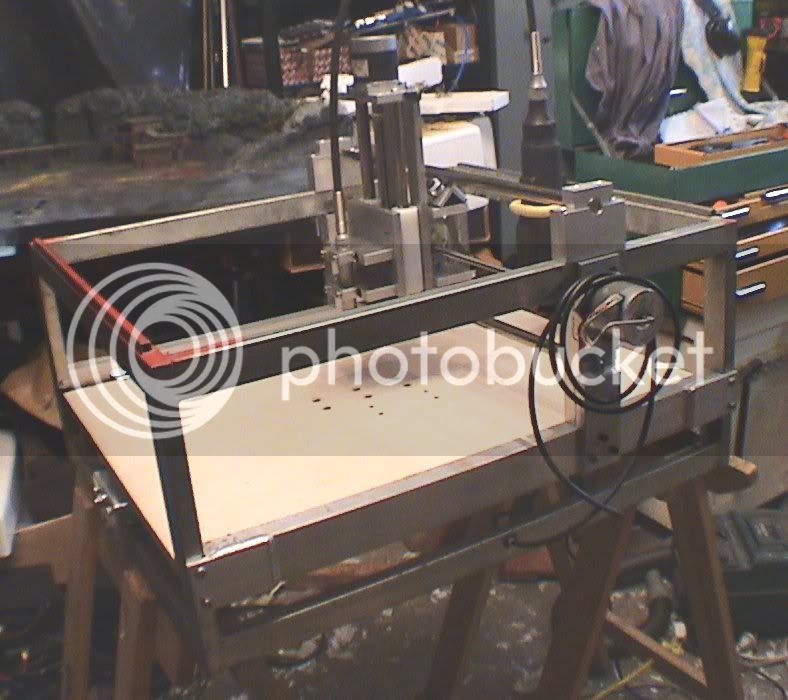- Joined
- Jan 19, 2010
- Messages
- 1,193
- Reaction score
- 41
Well, as some of you might have caught on by my previous threads, I am very interested and frustrated in buying a CNC machine. I have been looking in every corner of the internet for a ready to go machine, but none of them fit my qualifications. I would like large capacity about 12"X18" and ability to mill aluminum and steel, and all for $2000 or less. This seems like an impossible task.
In my searching I found a lot of CNC routers, but they all have major flaws when it comes to rigidity. Their support rails are usually undersized and unsupported, so flex and vibration would indeed plague these machines, although I am sure they work fine for balsa wood. Also their spindles are questionable. A Dremel, come on... Really?
So, that brings me to my plan.
Ah yes, a crazy plan it is.
For capacity, the Gantry style is it. I am thinking of using a Moving Table style gantry mill, where the Gantry is Fixed, and only used for the X and Z axis, and the table moves back and forth for the Y. ( On Gantry machines the X is on the Bridge, and the Y axis IS the Bridge or table)
OK, my plan is to use four 20mm round SUPPORTED rails mounted to the bottom of the table, with 8 bearing blocks mounted stationary on the base of the machine. The rails would provide a ton of support to the table, making it more rigid. Will I have trouble with four rails and 8 bearings?
Here are the rails.
http://cgi.ebay.com/ws/eBayISAPI.dl...255&ssPageName=STRK:MESINDXX:IT#ht_3883wt_922
Also the table will be made out of either 1" aluminum or 1/2" steel plate with tapped holes everywhere. Please tell me if this is overkill, these are quite expensive. This will be a lot of work so another option is the extruded aluminum rails found on most routers. But I am not sure of their rigidity.
The Frame construction will be 1/2" steel, along with the gantry support. There will be two 20mm supported rails mounted to 1/2" steel. The Z axis will be the same. Should I go thicker?
So far, with electronics but no spindle, I am at about $1300.
Let me know if I am just dreaming here. I have seen machines on u-tube with less structure than this mill steel and aluminum, albeit slowly.
Oh ya, 5/8" ballscrews on all axis also, along with 280oz/in stepper motors. Will 280 be enough? I am most worried about the Z axis strength. I want to keep the spindle options open, 40 - 50 pounds may not be out of the question.
Kel
In my searching I found a lot of CNC routers, but they all have major flaws when it comes to rigidity. Their support rails are usually undersized and unsupported, so flex and vibration would indeed plague these machines, although I am sure they work fine for balsa wood. Also their spindles are questionable. A Dremel, come on... Really?
So, that brings me to my plan.
Ah yes, a crazy plan it is.
For capacity, the Gantry style is it. I am thinking of using a Moving Table style gantry mill, where the Gantry is Fixed, and only used for the X and Z axis, and the table moves back and forth for the Y. ( On Gantry machines the X is on the Bridge, and the Y axis IS the Bridge or table)
OK, my plan is to use four 20mm round SUPPORTED rails mounted to the bottom of the table, with 8 bearing blocks mounted stationary on the base of the machine. The rails would provide a ton of support to the table, making it more rigid. Will I have trouble with four rails and 8 bearings?
Here are the rails.
http://cgi.ebay.com/ws/eBayISAPI.dl...255&ssPageName=STRK:MESINDXX:IT#ht_3883wt_922
Also the table will be made out of either 1" aluminum or 1/2" steel plate with tapped holes everywhere. Please tell me if this is overkill, these are quite expensive. This will be a lot of work so another option is the extruded aluminum rails found on most routers. But I am not sure of their rigidity.
The Frame construction will be 1/2" steel, along with the gantry support. There will be two 20mm supported rails mounted to 1/2" steel. The Z axis will be the same. Should I go thicker?
So far, with electronics but no spindle, I am at about $1300.
Let me know if I am just dreaming here. I have seen machines on u-tube with less structure than this mill steel and aluminum, albeit slowly.
Oh ya, 5/8" ballscrews on all axis also, along with 280oz/in stepper motors. Will 280 be enough? I am most worried about the Z axis strength. I want to keep the spindle options open, 40 - 50 pounds may not be out of the question.
Kel





